Index • FIDE 1948-1990 • Pre-FIDE • Highlights • Best games • News/Feedback • Gifts • Site map
World Chess Championship
|
||
Was there a reigning world champion?
After the first Karpov-Kasparov match was aborted by Campomanes, the question arose whether Karpov should be considered the reigning champion. Kasparov considered that Karpov no longer held the title, similar to the situation in 1946-48 after the death of Alekhine.
In past title matches over a fixed number of games, the reigning champion had enjoyed various advantages. In case of a tied match, the titleholder had always kept the title. In title matches played before 1963, the titleholder had also enjoyed a rematch clause, where a second match would be played if the challenger won the first match.
What would be done if the second match ended in a tie? Kasparov suggested that six additional games be played. If still tied, Karpov would become the world champion.
Similar considerations arose for a return match. If Karpov was not the reigning champion, any discussion of a return match would not be necessary.
In July 1985, the FIDE Executive council, meeting in Tunisia, decided that:-
- there would be a 24 game match.
- if the match ended 12-12, Karpov would keep the title.
- if Karpov lost, a return match would be granted, but this would be for the current cycle only and would not apply to future cycles. This meant that Kasparov would have to beat Karpov in one match and then hold him to at least a draw in a second. If he succeeded, he would not have the advantage of a return match in defending the world championship title.
- the loser of the return match would be seeded directly into a candidates final match for the current cycle. The match would consist of 24 games against the winner of the semifinal match. This meant that a new world champion challenger would have to beat both Karpov and Kasparov to gain the title.
Disputes about the match officials
The question arose as to which officials should serve as chief match arbiter and as chairman of the appeals committee. Kasparov was opposed to both Gligoric and Kinzel, whom he suspected of complicity with Karpov in agreeing to terminate the first match. L.Schmid was the only name on both Karpov's and Kasparov's list of acceptable arbiters.
In June, Campomanes announced that Gligoric would serve as chief match arbiter and Kinzel as chairman of the appeals committee. On 25 July, Gligoric announced that he was withdrawing his name. On 6 August, FIDE nevertheless declared officially that he would serve in the position. Two weeks later FIDE declared that L.Schmid was named to the position, but he had to decline because of other responsibilities.
FIDE later named A.Malchev of Bulgaria and V.Mikenas as co-arbiters, to serve on alternating games. A.Kinzel was named chairman of the match appeals committee.
Kasparov fights on and off the board
To keep his name before the public and to avoid any censorship by the Soviet authorities, Kasparov decided to play matches against R.Huebner in West Germany and U.Andersson in Yugoslavia. He selected the sites based on Kinzel's and Gligoric's nationalities.
In June, Kasparov played Huebner in Hamburg and won +3-0=3. The match was sponsored by Der Spiegel, to whom Kasparov granted an interview. He claimed that he was afraid that Campomanes, Karpov, and the leading officials of the Soviet Chess Federation were conspiring to halt the second match before it was played.
In July, Kasparov played Andersson in Belgrade and won +2-0=4. During the match Politika published his letter concerning his dispute with Gligoric.
In August, Kasparov was forbidden by the Soviet Federation to grant interviews to the foreign press. Kasparov's fear that the match would be cancelled was not realized.
During the match there was some harassment of Kasparov's supporters. A.Adorjan, a Hungarian GM who was to assist Kasparov, was denied an entry visa. R.Knezevic, Yugoslav photojournalist for Tanjug, the official Yugoslav news agency, was arrested while taking photos and was later expelled from the Soviet Union. In June, he had published an interview with Kasparov, who had criticized Karpov and Gligoric.
The match begins
The match took place in Moscow's Tchaikovsky concert hall, site of several WCC matches during the 1950s. Before the match last minute bids were received from Marseille and London. Karpov's choice was Moscow. Kasparov preferred not to play in Moscow and suggested Leningrad. Backed by the Soviet Chess Federation, FIDE selected Moscow.
At the time of the match, Karpov was 34 years old and rated 2720. Kasparov was 22 years old and rated 2700.
Karpov's seconds were GM S.Makarichev and I.Zaitsev. E.Geller and E.Vasiukov also assisted.
Kasparov replaced GM G.Timoshenko by GM J.Dorfman as his official second. Nikitin stayed. Timoshenko remained as an assistant with IM E.Vladimirov. Y.Razuvaev served as the chief of his delegation.
The opening ceremony was held on 2 September. Kasparov had White in the first game which was played on 3 September.
Game 1 - Nimzo Indian Defense Kasparov's choice of opening, which had not been seen in the first match, seemed to surprise Karpov, who started spending time on his 4th move. After 15 moves, Kasparov already had a better game. Kasparov slipped on his 20th move, but Karpov failed to take advantage of it. Karpov's 22...d5 allowed Kasparov to win a pawn, which proved decisive.
| Game 1 : Kasparov - Karpov |
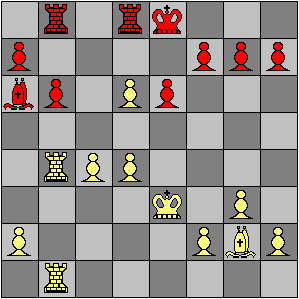
|
| after 23.c5-d6(xP e.p.) |
|
|
Kasparov sealed his 42nd move, but Karpov resigned before the second session. Counting the last two games of previous match, this was Karpov's third consecutive loss, which had never happened to him before.
It was the first time that Karpov trailed in a match since the 1974 candidates semifinal match against Spassky. It was also the first time that Kasparov held the lead in the two title matches.
Game 2 - Sicilian Defense In Karpov's first game of the match with White, the players followed game 45 of the previous match. Kasparov varied on his 13th move.
On his 21st move, Kasparov gave up two bishops in exchange for rook and pawn. Around move 30, he won another pawn, but then missed a win a few moves later.
| Game 2 : Karpov - Kasparov |
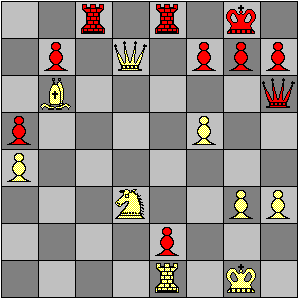
|
| after 34...Qd2-h6 |
| (34...Rf8 threatening ...Rc3 should win) |
|
|
Kasparov sealed his 41st move, overlooking the strongest continuation. Karpov regained a pawn at the start of the second session and the game became a B+N+Pfgh vs. R+Pafgh endgame. Kasparov missed the best continuation on his 52nd move and the game was drawn on the 65th move.
Karpov took a timeout for game 3.
Game 3 - Queen's Gambit Declined The game followed game 27 of the previous match, where Karpov played White. Kasparov varied from Karpov's continuation with his 7th move. After Karpov gained a slight advantage, Kasparov forced a simplification. The game was drawn after 20 moves, at Kasparov's proposal.
Game 4 - Queen's Gambit Declined The opening again followed game 27 of the first match, which Karpov had won. Kasparov varied with his 8th move. Kasparov played aggressively and weakened his K-side against a possible queen and bishop attack on the b1-h7 diagonal.
By the time the game was adjourned in Q+R+B+5P opposite color bishop endgame, Karpov had all of the winning chances, although many observers considered that Kasparov could hold the draw.

|
| Game 4 : Karpov - Kasparov |
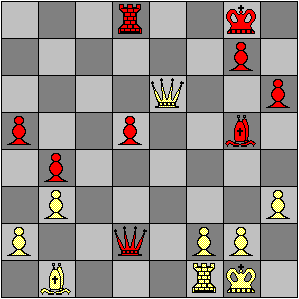
|
| after 41.Qf5-e6+ |
| (sealed) |
|
|
In the second session, Karpov managed to force the Black king to move into the center where the White rook joined the attack. Kasparov resigned on his 63rd move. The match score was tied at 2-2.
Game 5 - Ruy Lopez The opening followed game 46 of the previous match, until Karpov varied with his 15th move. After gaining a small advantage, Kasparov played aggressively with 20.c5, but the initiative passed to Karpov. Karpov won a pawn on his 26th move.

|
| Game 5 : Kasparov - Karpov |
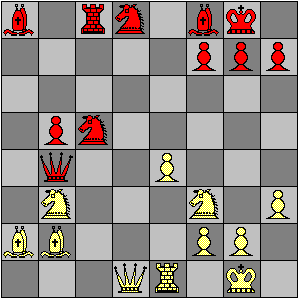
|
| after 25...Nd7-c5 |
|
|
When the first time control was reached, Karpov sealed, but Kasparov resigned before resumption in a technically lost endgame. Karpov now led 3-2. Kasparov would need to win two more games than Karpov to win the match and the title.
After losing two consecutive games, Kasparov took a timeout before game 6.
Game 6 - Queen's Gambit Declined The players repeated the opening of game 4, until Karpov varied with his 8th move. Kasparov sacrificed a pawn on his 16th move, getting an active rook in a R+N endgame as compensation. Karpov, unable to free his position, accepted a draw offer on his 28th move.
Game 7 - Nimzo Indian Defense Kasparov repeated the opening from game 1, but Karpov was now prepared for it and played a different variation on his 4th move. Kasparov sacrificed his g-pawn on his 11th move, which Karpov declined. Kasparov offered another pawn on his 19th move, which was accepted, and obtained open lines against Black's exposed king. Karpov defended by further opening his king position.
In time trouble, Karpov missed the strongest continuation on his 27th move. A few moves later, Kasparov sacrificed the exchange to achieve a perpetual check, and the game was agreed drawn.
Game 8 - Queen's Gambit Declined The players repeated an opening which had been seen 10 times during the first match, with Karpov playing White four times. All of the ten games had ended as draws. Karpov tried a new idea on his 16th move and gained a small advantage, but Kasparov sacrificed a pawn to obtain counterplay.

|
| Game 8 : Karpov - Kasparov |

|
| after 23...Nc5-e4 |
|
|
The game was adjourned in a R+Pag vs. R+Pg endgame, but was agreed drawn shortly after resumption.
Game 9 - Ruy Lopez The players followed game 5 until Karpov varied with his 12th move. With all the pieces on the board, the players maneuvered until move 31, when Kasparov suddenly opened the game and exchanged off all rooks.
There was some last minute jostling to see who would seal, and the task fell to Karpov. Kasparov seemed to have the worse of it, but he found some surprising resources and the game was drawn on the 53rd move in a Q+B+P vs. Q+4P endgame
Game 10 - Sicilian Defense The players repeated the opening from game 2. Karpov was the first to vary with 12.Bg1. To prevent his queen from being trapped, Kasparov sacrificed a pawn on his 21st move, and obtained good counterplay. Kasparov later sacrificed the exchange on his 31st move to arrive at a perpetual check.
Game 11 - Nimzo Indian Defense Karpov varied from game 7 on his 5th move, indicating that he was not satisfied with that previous game. Kasparov started to simplify on his 16th move and the game was even when Karpov blundered on his 22nd move. Kasparov's queen sacrifice ended the game immediately.

|
| Game 11 : Kasparov - Karpov |
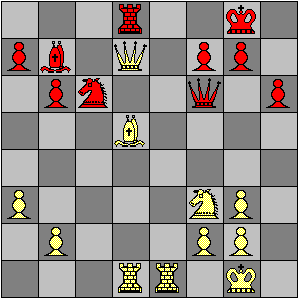
|
| after 23.Qg4-d7(xR) |
|
|
The match was again even at 5 1/2 points for each player.
Game 12 - Sicilian Defense The players followed game 3 of the first match, which Karpov had won. Kasparov uncorked a stunning novelty on his 8th move, which left Karpov scrambling to find the right line.
| Game 12 : Karpov - Kasparov |
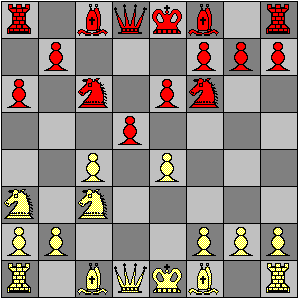
|
| after 8...d6-d5 |
|
|
The game was drawn after 18 moves, which left the score at six points for each player at match midpoint.
Game 13 - Nimzo Indian Defense Karpov returned to his defense from the first game, varying on his 5th move. Kasparov sacrificed a pawn on his 10th move, which he recovered a few moves later. Kasparov attained a better position, only to let it slip with his 18th move, when he should have put pressure on Karpov's b-pawn.
| Game 13 : Kasparov - Karpov |

|
| after 19...Qf6-h6 |
|
|
Karpov achieved equality and the game was drawn after 24 moves in an endgame of rooks and opposite colored bishops.
Game 14 - Sicilian Defense Karpov played 1.e4, changed variations to avoid Kasparov's game 12 novelty, and then produced a novelty of his own on the 6th move. Kasparov equalized and then played an unusual maneuver to activate his queen. The game was agreed drawn after 32 moves in the face of an opposite color bishop endgame.
Game 15 - Petrov's Defense Karpov defended against 1.e4 by returning to the opening seen in the last game of the first match and varying with his 7th move. Some subtle opening play by both players produced an even position which was drawn after 22 moves.
Game 16 - Sicilian Defense Both players steered into a repeat of Kasparov's game 12 novelty, so that the move would get its first real test. Kasparov avoided variations which recovered the sacrificed d-pawn and on his 16th move took control of the position with a knight on d3. It was a 'giant lobster' said one GM, referring to the piece's control over squares on White's back rank; 'an octopus' said another, referring to its control over a huge section of the board.
Karpov missed the chance to free his game with 17.d6. Kasparov played another stunning move with the following.






|
| Game 16 : Karpov - Kasparov |
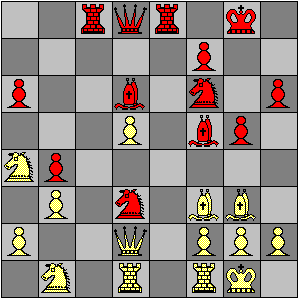
|
| after 21...g7-g5 |
|
|
Kasparov continued to increase his advantage in space until Karpov was forced to resign on his 40th move. The game was probably the most crucial of the match as it demonstrated the heights that Kasparov could reach. Chess Informant readers selected this game as the best game of the first 64 issues of the periodical.Kasparov again led the match with a score of 8.5-7.5.
Game 17 - Nimzo Indian Defense The opening repeated the 13th game. In response to a Karpov novelty on the 9th move, Kasparov ruined his pawn structure by accepting triple isolated pawns. Both players continued nervously until the game was drawn on the 29th move.
Kasparov took a timeout before game 18.
Game 18 - Sicilian Defense The players repeated the 2nd game until Karpov varied on his 14th move Karpov played aggressively, but then seemed to have second thoughts when he offered a draw on the 23rd move, which was accepted. It was the first game of the current match agreed drawn with most of the pieces still on the board.
Game 19 - Nimzo Indian Defense For the sixth time in the match, the players contested a Nimzo Indian, with Karpov trying a third idea on his 4th move. Kasparov sacrificed a pawn on his 11th move.

|
| Game 19 : Kasparov - Karpov |
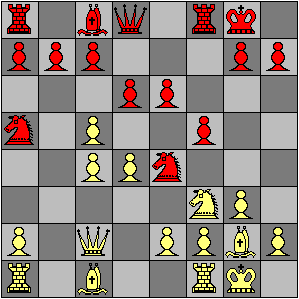
|
| after 11.c3-c4 |
|
|
Karpov declined, but handled the continuation unconvincingly. Kasparov had an advantage by move 20, but then began to play unconvincingly, letting part of his advantage slip. Around move 30, the game entered a phase of mutual time pressure. Kasparov's nerves proved stronger and Karpov blundered on his 39th move in a difficult position. He resigned just after the time control was reached, when Kasparov played his sealed move on the board.
Kasparov had scored +3-0=3 in the Nimzo Indian. With the score 10.5-8.5 in his favor with five games to play, Kasparov's chance of becoming world champion seemed almost certain. Karpov's best chance now was to win one game before the 24th game where he would have White. A win in the last game would then be enough to retain the title.
Game 20 - Queen's Gambit Declined For the first time in either match, Karpov played the Exchange Variation. Karpov gained a microscopic advantage and held it until adjournment. Kasparov sealed his 41st move, but showed his disdain for Karpov's winning attempts by playing his move on the board, as he had done in the previous game.
The game settled into a B+P endgame, where Karpov attempted to win through 83 moves. The game was finally agreed drawn when it became impossible to avoid a an endgame of lone king vs. bishop and h-pawn with a bishop of the wrong color.
Game 21 - Queen's Gambit Declined Now it was Kasparov's turn to play the Exchange variation. Karpov played an interesting novelty on his 9th move, but continued hesitantly and Kasparov obtained an edge by leaving his king in the center.

|
| Game 21 : Kasparov - Karpov |
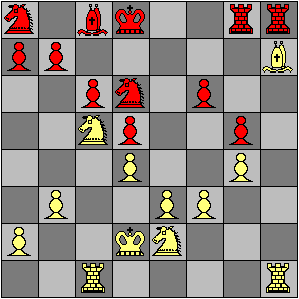
|
| after 27.Bd3-h7 |
|
|
Just before the time control, Kasparov overlooked the best continuation with 40.Ke3. On resumption, the game was drawn after a few moves, although many observers considered that Kasparov still had winning chances. Kasparov justified his decision by saying that at the board he noticed an error that had been made during adjournment analysis and lost faith in the analysis.
Down two points with three games to go, Karpov needed a win in the next game to have any hope of drawing the match. He took a timeout.
Game 22 - Queen's Gambit Declined The players followed game 20, until Karpov varied on his 6th move Kasparov gave the game a double-edged character by capturing 'away from the center' on his 11th move. Karpov played solidly, advanced his kingside pawns against Kasparov's castled king, exchanged queens, and brought up his king to support the pawns.

|
| Game 22 : Karpov - Kasparov |
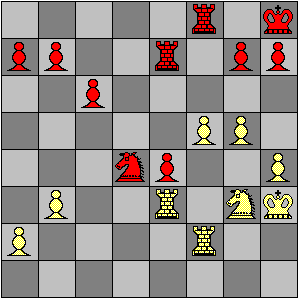
|
| after 34.Kh2-h3 |
|
|
Taking advantage of Kasparov's errors, Karpov reached an easily won R+P endgame. Kasparov resigned after the time control was reached.The score was 11.5-10.5. Kasparov needed one point in the last two games to win the title. Karpov needed a win and a draw to retain the title.
Game 23 - Queen's Gambit Declined The opening followed games 4 and 6, where Karpov had played the White pieces. Kasparov varied from the previous games on his 8th move.
Kasparov obtained a clear advantage, but faced with tough resistance, let the advantage slip. Kasparov offered the draw after his 41st move. The score was 12-11 in Kasparov's favor. Going into the final game, Karpov needed a win to retain the title, while Kasparov needed only a draw to win the title
Game 24 - Sicilian Defense The players followed the same opening which had been played in the 2nd, 10th, and 18th games. Karpov deviated from the 18th game with 15.g4, launching a typical Sicilian attack against Kasparov's king.


|
| Game 24 : Karpov - Kasparov |
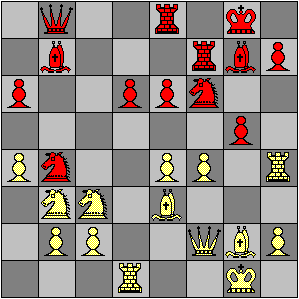
|
| after 31...g6-g5 |
|
|
Kasparov sacrificed his b-pawn on the 26th move and then his g-pawn on his 31st move to obtain an advantage in a complicated position. Karpov blundered on his 36th move, lost a piece, and resigned a few moves later.
On 9 November, having won the match by a score of 13-11, Kasparov became the 13th world champion.
|
WCC Index |
Results |
|
Previous |
Next |